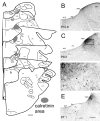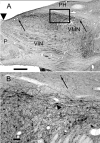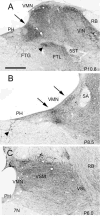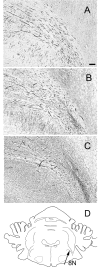Immunoreactivity for calcium-binding proteins defines subregions of the vestibular nuclear complex of the cat
- PMID: 15662522
- PMCID: PMC1201542
- DOI: 10.1007/s00221-004-2211-8
Immunoreactivity for calcium-binding proteins defines subregions of the vestibular nuclear complex of the cat
Abstract
The vestibular nuclear complex (VNC) is classically divided into four nuclei on the basis of cytoarchitectonics. However, anatomical data on the distribution of afferents to the VNC and the distribution of cells of origin of different efferent pathways suggest a more complex internal organization. Immunoreactivity for calcium-binding proteins has proven useful in many areas of the brain for revealing structure not visible with cell, fiber or Golgi stains. We have looked at the VNC of the cat using immunoreactivity for the calcium-binding proteins calbindin, calretinin and parvalbumin. Immunoreactivity for calretinin revealed a small, intensely stained region of cell bodies and processes just beneath the fourth ventricle in the medial vestibular nucleus. A presumably homologous region has been described in rodents. The calretinin-immunoreactive cells in this region were also immunoreactive for choline acetyltransferase. Evidence from other studies suggests that the calretinin region contributes to pathways involved in eye movement modulation but not generation. There were focal dense regions of fibers immunoreactive to calbindin in the medial and inferior nuclei, with an especially dense region of label at the border of the medial nucleus and the nucleus prepositus hypoglossi. There is anatomical evidence that suggests that the likely source of these calbindin-immunoreactive fibers is the flocculus of the cerebellum. The distribution of calbindin-immunoreactive fibers in the lateral and superior nuclei was much more uniform. Immunoreactivity to parvalbumin was widespread in fibers distributed throughout the VNC. The results suggest that neurochemical techniques may help to reveal the internal complexity in VNC organization.
Figures








References
-
- Adams JC. Heavy metal enhancement of DAB-based HRP reaction product. J Histochem Cytochem. 1981;29:775. - PubMed
-
- Akaike T. Neuronal organization of the vestibulospinal system in the cat. Brain Res. 1983;259:217–227. - PubMed
-
- Angaut P, Brodal A. The projection of the “vestibulocerebellum” onto the vestibular nuclei in the cat. Arch Ital Biol. 1967;105:441–479. - PubMed
-
- Arai R, Winsky L, Arai M, Jacobowitz DM. Immunohistochemical localization of calretinin in the rat hindbrain. J Comp Neurol. 1991;310:21–44. - PubMed
-
- Baimbridge KG, Celio MR, Rogers JH. Calcium-binding proteins in the nervous system. Trends Neurosci. 1992;15:303–308. - PubMed
Publication types
MeSH terms
Substances
Grants and funding
LinkOut - more resources
Full Text Sources
Miscellaneous

